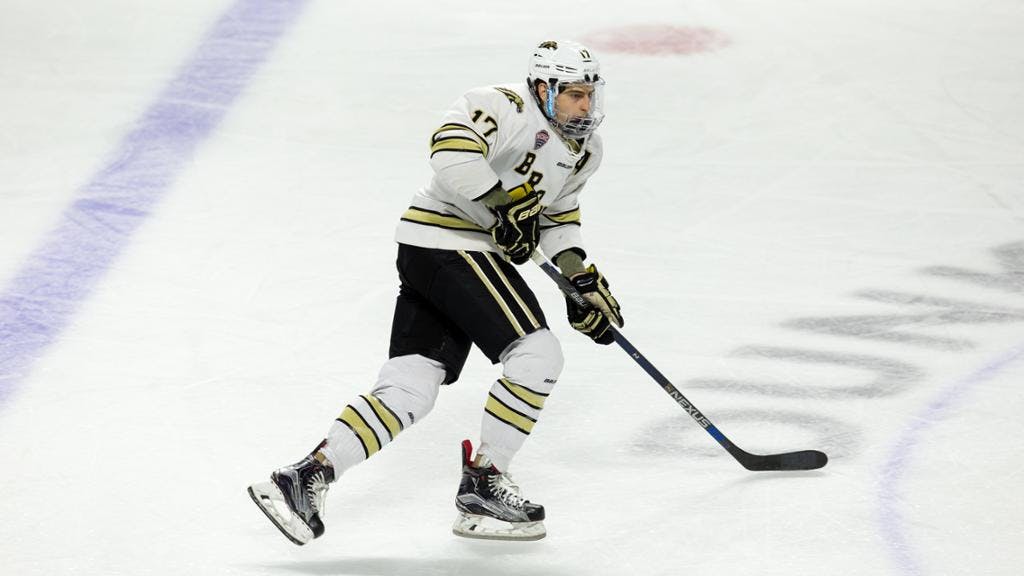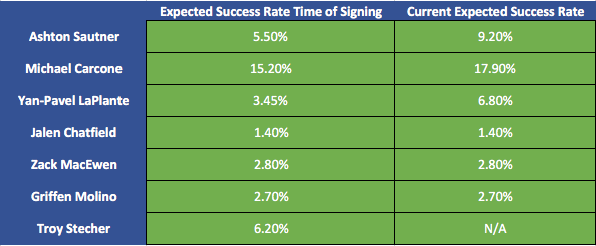Death by a Thousand Contracts

By J.D. Burke
7 years agoThe Vancouver Canucks confirmed a John Buccigross report from earlier this week when they announced they’d come to terms with University of Western Michigan’s Griffen Molino to a two-year entry-level contract.
This marks the third time the Canucks have ventured into the unrestricted free agent pool to try and unearth young talent that’s slipped through the cracks of the NHL entry draft in this season and the seventh occasion since Canucks general manager Jim Benning took the job three years ago.
At a glance, one can certainly appreciate the Canucks not leaving any stones unturned in the pursuit of fresh young talent to invigorate the ranks. The beauty of adding an undrafted free agent is it doesn’t cost anything except cash and a standard player contract against a team’s upper limit of 50.
If you have the logistical flexibility, it can make sense to dip into that market as often as possible. That first point matters, though, because each free agent is another contract towards the maximum and they eventually add up. It’s a double-edged sword and the team that wields it has to be judicious in how often they swing it.
The most recent Canucks signing doesn’t seem to reflect that level of discipline. As Canucks Army’s Ryan Biech pointed out in his article on unrestricted college free agents, Molino’s meek statistical profile suggests he’s highly unlikely to develop into a professional NHL’er. In fact, at the time Biech profiled those collegiate forwards, Molino’s expected success rate by pGPS (Prospect Graduation Probabilities System) was the lowest among the entire crop of NCAA centres he bothered examining.
That wouldn’t be such a problem if we could write this off as one of a kind, low probability bet that can be explained by Benning’s scouting success as a counterweight to the quantitative landmine it seems they’ve jumped on with glee. I’m willing to turn a blind eye to this kind of contract if it’s the exception and not the rule. If that was only the case.

Now the pGPS system that we so frequently lean on in this space isn’t a perfect tool. While the research Jeremy Davis has done shows it to be a predictive metric for draft success, the very fact that it uses historical principle as a threshold means it’s imperfect in nature. A player can, hypothetically, have a zero percent expected success rate and make the NHL — it’s just supremely unlikely.
With that caveat, we can look into each of the Canucks’ undrafted free agent signings and the principle for success with each. And the picture is bleak. If you combine the success percentage of each undrafted prospect the Canucks have signed, the expected success rate is 37.25 — less than half of an NHL player. That’s seven players worth and not many reasons to expect more than the one NHL’er they’ve already squeezed from the lot.
It would be disingenuous if I didn’t add that one part of that sum, Troy Stecher, is in the midst of his first season in what looks like it will be a distinguished NHL career for many to come. I think everyone involved would suggest that Stecher’s expected success rate belied his potential, though. That’s bound to happen when one uses a metric based on historical principle, and to that exact end, we should allow a certain amount of wiggle room to the decision makers involved to put their acumen against this methodology or any of its kind from time to time.
How much wiggle room is a worthwhile question, though. Assuming the Canucks don’t add another undrafted free agent, Molino makes seven contracts added through this route. That’s 14% of the Canucks 50 contract limit, and six of the players that account for that number are even money to combine for 100 NHL games played.
Frankly, I’d set that number at one NHL game played if not for the Canucks burning the first of Molino’s two-year deal by playing him as early as this Friday — a savvy move, which effectively turns his contract into a one-year deal with a couple of weeks on top.
This might not seem like it’s worth worrying about, but there can be very real ramifications for throwing contracts around with reckless abandon. Each sound, high percentage play on the waiver wire requires the requisite room against the contract limit to work. Imagine a world where the Canucks can’t put a claim on the next Mike Hoffman, Reid Boucher, Magnus Paajarvi, Martin St. Louis or David Schlemko because they just had to get their hands on Molino or a player of that ilk? What of the number of other, readily available undrafted prospects with a significantly better precedent for success?
Some of these gains I’m pleading the Canucks grant themselves the flexibility to make may seem insignificant, but running an NHL hockey team is an efficiency contest where everyone works from a capped resource base. It’s not “just one contract, ah whatever” when it happens seven times over and the quantitative support for each decision is less and less solvent.
The Canucks have 49 contracts against their 50 limit as they enter the final week of their season. They’re already committed to 31 contracts for next season per www.CapFriendly.com, but that number swells to 40 when one accounts for the restricted free agents Vancouver is likely to sign, and that’s a fairly conservative estimate. Then there’s the matter of their own draft picks and adding players to fill the significant gaps in their NHL roster.
That doesn’t leave the Canucks a large margin for error. Then again, they seem to like working under those auspices. They’d be far more judicious in their approach at free agency otherwise.
Recent articles from J.D. Burke





